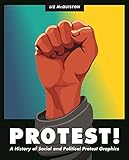Protest! : A History of Social and Political Protest Graphics / Liz McQuiston.
Material type: TextPublisher: Princeton, NJ : Princeton University Press, [2019]Copyright date: ©2019Description: 1 online resource (288 p.) : 400 color illusContent type:
TextPublisher: Princeton, NJ : Princeton University Press, [2019]Copyright date: ©2019Description: 1 online resource (288 p.) : 400 color illusContent type: - 9780691198330
- 9780691197319
- Political art
- Political posters -- History
- Protest movements
- ART / Art & Politics
- Activism
- Adolf Hitler
- Adolf
- Advertising campaign
- Advertising
- Alamy
- Alberto Korda
- Anti-war movement
- Apartheid
- Art movement
- Ben Shahn
- Black people
- Campaign for Nuclear Disarmament
- Caricature
- Cartoon
- Cartoonist
- Charlie Hebdo
- Che Guevara
- Civil disobedience
- Civilization
- Combatant
- Communism
- Dada
- Defamation
- Designer
- Dictatorship
- Editorial cartoon
- El Lissitzky
- Emblem
- Environmentalism
- Feminism (international relations)
- Feminism
- Film poster
- George Grosz
- Global warming
- Guerrilla Girls
- Gulf War
- Harper's Weekly
- Headline
- Iconography
- Illustration
- Illustrator
- James Gillray
- Je suis Charlie
- Jesus Barraza
- John Heartfield
- LGBT
- Le Charivari
- Manifesto
- March on Washington for Jobs and Freedom
- Modernism
- Mushroom cloud
- National Association for the Advancement of Colored People
- Nazi Germany
- Nazi Party
- Nazism
- Newspaper
- Nicaragua
- Nuclear disarmament
- Nuclear warfare
- Nuclear weapon
- Pamphlet
- Pass laws
- Photomontage
- Political satire
- Politician
- Postcard
- Poster
- Power politics
- Princeton University Press
- Protest
- Publication
- Publishing
- Racial segregation
- Racism
- Riot police
- Sacco and Vanzetti
- Satire
- See Red Women's Workshop
- Sexism
- Simplicissimus
- Soviet Union
- Spanish Civil War
- Special Relationship
- Suffrage
- Suffragette
- Tear gas
- Technology
- Terrorism
- The Quarto Group
- Their Lives
- Thomas Nast
- Thomas Rowlandson
- To This Day
- Trade union
- Trafalgar Square
- Trayvon Martin
- Tristan Tzara
- Typography
- Unemployment
- online - DeGruyter
| Item type | Current library | Call number | URL | Status | Notes | Barcode | |
|---|---|---|---|---|---|---|---|
 eBook
eBook
|
Biblioteca "Angelicum" Pont. Univ. S.Tommaso d'Aquino Nuvola online | online - DeGruyter (Browse shelf(Opens below)) | Online access | Not for loan (Accesso limitato) | Accesso per gli utenti autorizzati / Access for authorized users | (dgr)9780691197319 |
Browsing Biblioteca "Angelicum" Pont. Univ. S.Tommaso d'Aquino shelves, Shelving location: Nuvola online Close shelf browser (Hides shelf browser)

|

|

|

|

|

|

|
||
| online - DeGruyter Indian Sex Life : Sexuality and the Colonial Origins of Modern Social Thought / | online - DeGruyter Spinoza's Ethics / | online - DeGruyter Only Yesterday : A Novel / | online - DeGruyter Protest! : A History of Social and Political Protest Graphics / | online - DeGruyter Wilhelm Dilthey: Selected Works, Volume VI : Ethical and World-View Philosophy / | online - DeGruyter The Fire Is upon Us : James Baldwin, William F. Buckley Jr., and the Debate over Race in America / | online - DeGruyter The World Philosophy Made : From Plato to the Digital Age / |
Frontmatter -- Contents -- Introduction -- 1. Early Developments: The Reformation and Social Comment (1500–1900) -- 2. Constructing a New Society (1900–1930) -- 3. Fascism, The Cold War and The Bomb (1930–1960) -- 4. Redirection and Change (1960–1980) -- 5. The AIDS Crisis and Other Global Tensions (1980–2000) -- 6. Revolutions and the Demand for Rights (2000–Present) -- Endnotes -- Bibliography -- Index -- Picture Credits -- Acknowledgements
restricted access online access with authorization star
http://purl.org/coar/access_right/c_16ec
An authoritative, richly illustrated history of six centuries of global protest artThroughout history, artists and citizens have turned to protest art as a means of demonstrating social and political discontent. From the earliest broadsheets in the 1500s to engravings, photolithographs, prints, posters, murals, graffiti, and political cartoons, these endlessly inventive graphic forms have symbolized and spurred on power struggles, rebellions, spirited causes, and calls to arms. Spanning continents and centuries, Protest! presents a major new chronological look at protest graphics.Beginning in the Reformation, when printed visual matter was first produced in multiples, Liz McQuiston follows the iconic images that have accompanied movements and events around the world. She examines fine art and propaganda, including William Hogarth’s Gin Lane, Thomas Nast’s political caricatures, French and British comics, postcards from the women’s suffrage movement, clothing of the 1960s counterculture, the anti-apartheid illustrated book How to Commit Suicide in South Africa, the “Silence=Death” emblem from the AIDS crisis, murals created during the Arab Spring, electronic graphics from Hong Kong’s Umbrella Revolution, and the front cover of the magazine Charlie Hebdo. Providing a visual exploration both joyful and brutal, McQuiston discusses how graphics have been used to protest wars, call for the end to racial discrimination, demand freedom from tyranny, and satirize authority figures and regimes.From the French, Mexican, and Sandinista revolutions to the American civil rights movement, nuclear disarmament, and the Women’s March of 2017, Protest! documents the integral role of the visual arts in passionate efforts for change.
Mode of access: Internet via World Wide Web.
In English.
Description based on online resource; title from PDF title page (publisher's Web site, viewed 27. Jan 2023)


